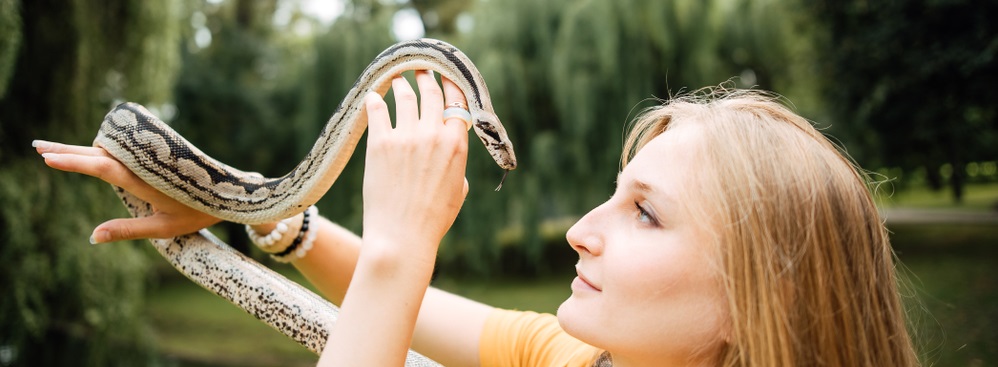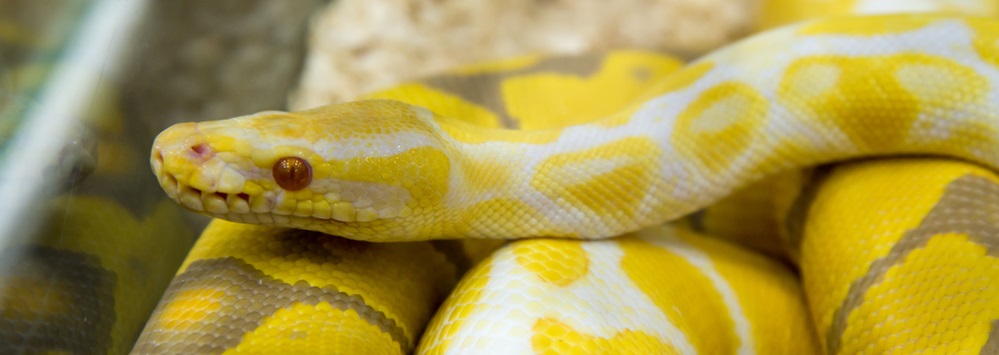Snakes are incredible creatures and awesome pets—but they may not be the smartest animals in the kingdom (sorry). Sometimes, they slither right up to their heat lamps and singe their scaly skin without even realizing it.
These lamps are essential, but they also pose a risk to your scaly companion. So what do you do?
Keep reading to learn all about lamp burns, including how to treat and prevent them.
Why Are Snakes So Susceptible to Burns?
Burns are one of the most common injuries sustained by snakes. The science isn’t 100% clear on why, but there are a few leading theories:
- Lack of reason and understanding – There’s a reason people refer to your “reptilian” or “lizard brain” as a separate entity from your higher-order cognitive functioning skills like critical thinking and complex analysis. Reptiles don’t have the same reasoning skills that us humans, or even other mammals, do. They may feel the pain of the heat source, but they don’t necessarily associate this pain with the object, so they don’t immediately move away from it the way a human would (hopefully).
- No evolutionary significance to heat-pain receptors – For millions of years, reptiles lived in the wild, developing reflexes and physical characteristics that would help them survive. But heat lamps were never part of that environment. Now that they are, domesticated snakes may not have the ingrained reflex to pull away from them.
Recognizing the Signs
You may not realize your snake’s been burned right away. You were likely out of the room when it happened, and reptiles don’t exactly cry and whine the way injured dogs and cats do. It’s important to keep an eye out for any indications of a burn in your serpentine friend:
- First degree – These painful, surface-level burns affect the skin’s outer layer (epidermis). You might notice dark discoloration underneath the scales, red skin, singed scales, and sometimes blisters.
- Second degree – These deeper burns often destroy the entire epidermis. Look out for significant swelling, blistering, discharge, and tissue discoloration. After some time, you may see what looks like a scab covering the open wound.
- Third degree – These intense injuries destroy the animal’s pain receptors, making them painless but potentially dangerous. The tissue may look discolored, sometimes completely blackened, and the wound will be quite deep.
First degree burns, as long as they’re relatively small and manageable, can be treated from the comfort of your home. More severe burns should receive prompt medical attention.
Treating the Burn
Reptiles have a superpower: an incredible capacity for self-healing.
Maybe it’s because of their thick, scaly exteriors, or the fact that they can shed their outer layer and regenerate new, healthy skin underneath—no matter the reason, it helps significantly in their healing process.
But they can’t do it alone.
Here’s how you can help them:
- Immediately run the injury under cold water or apply a cold compress for 15-20 minutes, the same as if you had burned yourself. Do NOT use ice, as it can cause frostbite and tissue damage.
- Leave blisters alone. Do NOT break them, as this eliminates the body’s natural defense against infection.
- Gently clean the wound with antibacterial soap and remove any potential contaminants.
- Apply a topical antimicrobial skin treatment to soothe the damaged skin and speed up the healing.
- Cover the burn wound with a non-stick, waterproof bandage to avoid infection.
- OPTIONAL: Move them to a temporary glass enclosure, free from natural terrain and substrate (bedding). This isn’t ideal for long stretches of time, but the sterilized, easy-to-clean environment will reduce infections while the burn heals.
You should continue to clean the wound and apply the topical spray as long as the burn is in recovery. Minor burns are easy enough to treat, but it’s much more difficult to deal with any infections that might develop as a result.
Preventing the Burn
How can you prevent a lamp burn when heat lamps are necessary for a proper reptilian environment?
Here are a few easy ways:
- Distance between the source and the snake – You can either install a screen between the snake’s habitat and the heat lamps, or place the light high enough that the snake can’t reach, even as they climb on elevated branches and rocks.
- Proper reptile heating lamps – You shouldn’t attach just any old light to your reptile’s cage. Use a ceramic or porcelain socket and avoid halogen lamps, which retain heat long after you’ve turned them off. Incandescent heat bulbs are usually best, with lower wattages for smaller enclosures.
The (Lamp) Light at the End of the Tunnel
The good news is that many lamp burns are minor, first-degree injuries. The better news is that you can easily treat them from home with basic first aid supplies like Vetericyn’s multipurpose wound and skin care treatment and non-stick bandages.
Hopefully, with this helpful guide, your slithering pal will be back to normal in no time—and if you’re lucky, they may even learn from their mistakes (but no promises).
Sources:
- dvm360. Understanding thermal burns in reptile patients (Proceedings). https://www.dvm360.com/view/understanding-thermal-burns-reptile-patients-proceedings
- PetMD. Burns in Reptiles. https://www.petmd.com/reptile/emergency/accidents-injuries/e_rp_burns_in_reptiles

